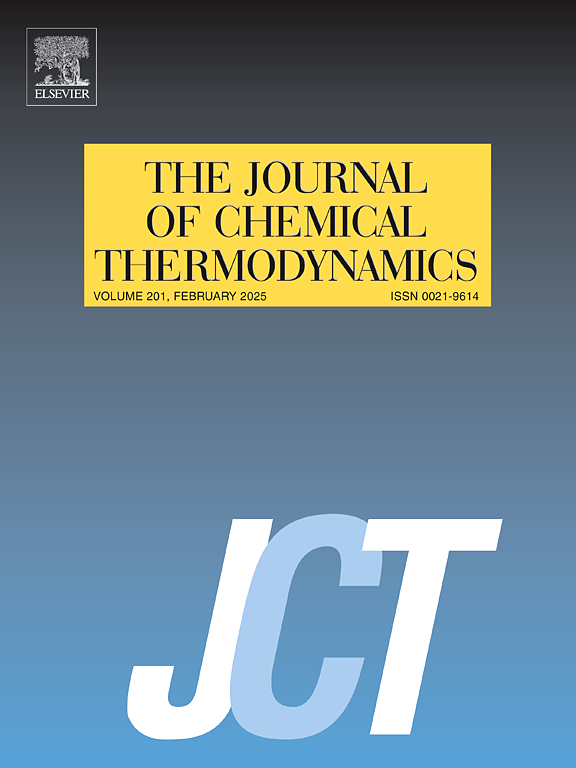尿素在极性质子溶剂中溶解度的测定及数学关联
IF 2.2
3区 工程技术
Q3 CHEMISTRY, PHYSICAL
引用次数: 0
摘要
准确测定药物活性成分在溶剂中的溶解度对纯化工艺的设计和开发至关重要。用干燥重量法测定了尿素在20 ~ 70℃(293.15 ~ 343.15 K) 9种极性质子溶剂(水、甲醇、乙醇、1-丙醇、异丙醇、1-丁醇、异丁醇、1-戊醇和异戊醇)中的溶解度,发现尿素在所选溶剂中的溶解度随温度的升高而升高。尿素在水中溶解度最高,在戊醇中溶解度最低。尿素溶解度的摩尔分数(x)与修正的Apelblat方程和λh方程相关。预测的最大相对平均辐射(RAD)和均方根偏差(RMSD)分别为0.0021 (Apelblat)和0.0011 (λh)。RMSD最大值分别为3.57 × 10−8 (Apelblat)和0.6160 × 10−8 (λh)。所得的λh方程与尿素溶解度的实验值吻合较好。在所有选择的溶剂中,RAD和RMSD值都较小,分别在- 0.0006 ~ 0.0011和0.0003 × 10−8 ~ 0.6160 × 10−8之间。利用van ' t Hoff方程计算了溶液的热力学能量性质。所得值ΔH、ΔS和ΔG均为正,表明溶出过程为吸热、熵驱动的非自发过程。水表现出最有利的尿素溶解热力学,这可能是由于与酒精溶剂相比,水具有更高的极性和线性结构,产生了更强的相互作用。尿素的溶解度数据、溶解度模型和热力学参数对工业尿素的生产和结晶应用具有重要意义。本文章由计算机程序翻译,如有差异,请以英文原文为准。
Measurement and mathematical correlation of the solubility of urea in polar protic solvents
The accurate determination of the solubility of an active pharmaceutical ingredient in a solvent is essential for the design and development of the purification process. The solubility of urea in nine polar protic solvents (water, methanol, ethanol, 1-propanol, isopropanol, 1-butanol, isobutanol, 1-pentanol and isopentanol) was measured by dried gravimetric method from 20-70 °C (293.15–343.15 K). The solubility of urea in selected solvents was found to increases with temperature. The solubility of urea was highest in water and lowest in pentanol. The mole fraction (x) solubility of urea was correlated with the modified Apelblat equation and λh equation. The maximum relative average radiation (RAD) and root-mean-square deviation (RMSD) predicted were 0.0021 (Apelblat) and 0.0011 (λh), respectively. The maximum values of RMSD were 3.57 × 10−8 (Apelblat) and 0.6160 × 10−8 (λh), respectively. The λh equation showed a better fit with experimental values for the solubility of urea. The RAD and RMSD values were smaller in all selected solvents, ranging from −0.0006 to 0.0011 and 0.0003 × 10−8 to 0.6160 × 10−8, respectively. The thermodynamic energy properties of the solution were calculated using the van ’t Hoff equation. The obtained values of ΔH, ΔS and ΔG were found to be positive, indicating that the dissolution process was an endothermic, entropy-driven and non-spontaneous process. Water exhibited the most favourable thermodynamics for urea dissolution, likely due to stronger interactions arising from its higher polarity and linear structure compared to the alcoholic solvents. The solubility data, solubility model and thermodynamic parameters of urea are of great significance to the application of industrial urea production and crystallisation.
求助全文
通过发布文献求助,成功后即可免费获取论文全文。
去求助
来源期刊

Journal of Chemical Thermodynamics
工程技术-热力学
CiteScore
5.60
自引率
15.40%
发文量
199
审稿时长
79 days
期刊介绍:
The Journal of Chemical Thermodynamics exists primarily for dissemination of significant new knowledge in experimental equilibrium thermodynamics and transport properties of chemical systems. The defining attributes of The Journal are the quality and relevance of the papers published.
The Journal publishes work relating to gases, liquids, solids, polymers, mixtures, solutions and interfaces. Studies on systems with variability, such as biological or bio-based materials, gas hydrates, among others, will also be considered provided these are well characterized and reproducible where possible. Experimental methods should be described in sufficient detail to allow critical assessment of the accuracy claimed.
Authors are encouraged to provide physical or chemical interpretations of the results. Articles can contain modelling sections providing representations of data or molecular insights into the properties or transformations studied. Theoretical papers on chemical thermodynamics using molecular theory or modelling are also considered.
The Journal welcomes review articles in the field of chemical thermodynamics but prospective authors should first consult one of the Editors concerning the suitability of the proposed review.
Contributions of a routine nature or reporting on uncharacterised materials are not accepted.
 求助内容:
求助内容: 应助结果提醒方式:
应助结果提醒方式:


